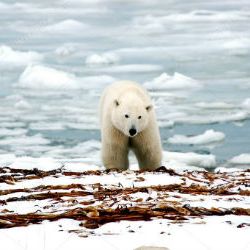Global Warming Poses Additional Threat Of Polar Bears Being Hunted

Polar bears already face the threat of receding ice levels and declining sources of food in the Arctic. If that is not enough, they face additional dangers as a result of global warming because they are now prey for killer whales and sharks. As the Arctic ice recedes, polar bears find it increasingly difficult to hunt for seals that make up the vast majority of their diet and this means they are being forced to swim ever greater distances.
Time in the water puts polar bears at risk
The fact that the polar bear now has to spend more time in the water puts them at risk of both killer whales and Greenland sharks which are migrating northwards with the melting of the ice. Kit Kovacks who is a professor of marine biology at the Norwegian Polar Institute has said he has seen a polar bear jaw in the stomach of a shark, though he does not know whether the shark killed the bear or whether the bear was already dead.
Arctic sea ice acts as a barrier to killer whales
Killer whales also feed on bowhead whales, beluga whales, narwhals and seals, most of which are usually protected by the thick sea ice for the vast majority of the year. Killer whales tend to avoid ice because it causes damage to their long fins. Now the ice has melted, there is no protection left. In fact, it has been estimated that within the next two decades there will be no ice left in the Arctic whatsoever. In the Hudson Bay, it is estimated that there are 57,000 beluga whales who are at risk of being hunted down as prey for killer whales.
Killer whales at the top of the food chain
Steve Ferguson a researcher from Manitoba University recently attended the ArcticNet scientific conference where he told the audience that ultimately the killer whale could find itself at the top of the food chain in the Arctic. That means more bad news for polar bears who can expect to see their population decline by a third by 2050.



